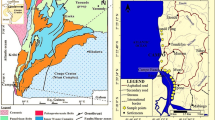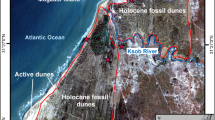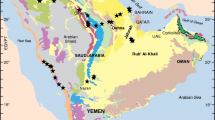Abstract
Texture, mineralogy, and major and trace element geochemistry of 26 coastal dune sand samples were studied to determine the provenance and tectonic environment of two dune fields close to the beaches of Safaga (SF) and Quseir (QS) at the Egyptian Red Sea coast. Onshore winds generate fine, moderate, moderately-well to well-sorted, coarse-skewed to near-symmetrical dune sands with mesokurtic distributions. Winds pick up and transport grains from nearby beach sands and alluvial deposits into a wide Red Sea coastal plain at the border of the beach. The mineralogical (Qt–Ft–Lt) and geochemical composition of the sands, indicate that SF and QS coastal dune sands are mature and influenced by quartz-rich sands. The average CIA values in SF and QS coastal dune sands are low relative to the range of the PAAS, suggesting an arid climate and a low intensity of chemical weathering. The SF and QS coastal dune sand samples are plotted in the recycled orogen and partly in craton interior fields suggesting recycled older sedimentary and partly metamorphic-plutonic sources. The high content of quartz with shell debris and carbonates in coastal dune sands support the recycled sedimentary beach and alluvial sand sources. The dominance of heavy minerals like amphiboles (hornblende) and biotite in the coastal dune sands also supports the effect of metamorphic-plutonic source rocks. The new tectonic discriminant-function diagrams suggest that the coastal dune sands were deposited in a passive margin of a synrift basin. The results provide a good evidence for the extension in the Red Sea rift system during Oligocene-post Pliocene, which is consistent with the general geology of Egypt.

(modified after Conoco 1987).











Similar content being viewed by others
References
Al-Habri O A and Khan M M 2008 Provenance, diagenesis, tectonic setting and geochemistry of Tawil sandstone (Lower Devonian in central Saudi Arabia); J. Asian Earth Sci. 33 278–287.
Armstrong-Altrin J S 2009 Provenance of sands from Cazones, Acapulco, and Bahía Kino beaches; Mexico; Rev. Mex. Cienc. Geol. 26(3) 764–782.
Armstrong-Altrin J S 2015 Evaluation of two multidimensional discrimination diagrams from beach and deep-sea sediments from the Gulf of Mexico and their application to Precambrian clastic sedimentary rocks; Int. Geol. Rev. 57 1446–1461.
Armstrong-Altrin J S, Lee Y I, Verma S P, Ramasamy S 2004 Geochemistry of sandstones from the Upper Miocene Kudankulam Formation, southern India: Implications for provenance, weathering, and tectonic setting; J. Sedim. Res. 74 285–297.
Armstrong-Altrin J S, Lee Y I, Kasper-Zubillaga J J, Carranza-Edwards A, Garcia D, Eby N, Balaram V and Cruz-Ortiz N L 2012 Geochemistry of beach sands along the western Gulf of Mexico, Mexico: Implication for provenance; Chem. Erde. Geochem. 72 345–362.
Armstrong-Altrin J S, Machain-Castillo M L, Rosales-Hoz L, Carranza-Edwards A, Sanchez-Cabeza J A and Ruíz-Fernández A C 2015a Provenance and depositional history of continental slope sediments in the southwestern Gulf of Mexico unraveled by geochemical analysis; Cont. Shelf Res. 95 15–26.
Blatt H, Middleton G and Murray R 1980 Origin of Sedimentary Rocks; Prentice-Hall, New Jersey, 362p.
Carranza-Edwards A 2001 Grain size and sorting in modern beach sands; J. Coast. Res. 17(1) 38–52.
Carranza-Edwards A, Kasper-Zubillaga J J, Rosales-Hoz L, Alfredo-Morales E and Santa-Cruz R L 2009 Beach sand composition and provenance in a sector of the southwestern Mexican Pacific; Rev. Mex. Cienc. Geol. 26(2) 433–447.
Conoco 1987 Geological Map of Egypt, Scale (1:500,000), NH 36 SW-B.S. sheet.
Cox R, Lowe D R and Cullers R L 1995 The influence of sediment recycling and basement composition on evolution of mudrock chemistry in the southwestern United States; Geochim. Cosmochim. Acta 59 2919–2940.
Dar M A 1998 Mineralogy and chemistry of the mangrove vegetation in Hurghada–Quseir area, Red Sea, Egypt; M.Sc. Thesis, Faculty of Science, Suez Canal University, 225p.
Dar M A 2002 Geological bases to study the environmental defect in the marine ecosystem as a result of touristic activities in Hurghada area and surroundings. Red Sea, Egypt; Ph.D. Thesis, Suez Canal University; 2l8p.
Dickinson W R, Beard L S, Brakenridge G R, Erjavec J L, Ferguson R C, Inman K F, Knepp R A, Lindberg F A and Ryberg P T 1983 Provenance of North American Phanerozoic sandstones in relation to tectonic setting; Geol. Soc. Am. Bull. 94 222–235.
Dott R H 1964 Wackes, greywacke and matrix: What approach to immature sandstone classification; J. Sedim. Petrol. 34 625–632.
Egyptian Meteorological Authority, Ministry of Transportation and Communications (1996), internal meteorological reports, Cairo, 37p.
El-Taher A and Madkour H A 2013 Texture and environmental radioactivity measurements of Safaga sand dunes; Indian J. Geo-marine Sci. 42(1) 35–41.
Folk R L 1966 A review of grain-size parameters; Sedimentology 6 73–96.
Folk R L 1980 Petrology of sedimentary rocks; Hemphill Publ. Co., Texas, 159p.
Franzinelli E and Potter P E 1983 Petrology, chemistry and texture of modern river sands, Amazon River System;J. Geol. 91(1) 23–29.
Fryberger S G 1979 Dune forms and wind regime; In: A study of global sand seas (ed.) Mckee, Prof. Pap. US Geol. Surv. 1052.5.2.5, pp. 137–169.
Hill I G, Meighan I G and Worden R H 2000 Yttrium: The immobility–mobility transition during basaltic weathering; Geology 28 923–926.
Honda M, Yabuki S and Shimizu H 2004 Geochemical and isotopic studies of aeolian sediments in China; Sedimentology 51 211–230.
Kassi A M, Grigsby J D, Khan A S and Kasi A K 2015 Sandstone petrology and geochemistry of the Oligocene–Early Miocene Panjgur Formation, Makran accretionary wedge, southwest Pakistan: Implications for provenance, weathering and tectonic setting; J. Asian Earth Sci. 105 192–207.
Kasper-Zubillaga J J and Zolezzi-Ruiz H 2007 Grain size, mineralogical and geochemical studies of coastal and inland dune sands from El Vizcaíno Desert, Baja California Peninsula, Mexico; Rev. Mex. Cienc. Geol. 24(3) 423–438.
Kasper-Zubillaga J J, Armstrong-Altrin J S, Carranza Edwards A, Morton-Bermea O and Lozano-Santa Cruz R 2013 Control in beach and dune sands of the Gulf of Mexico and the role of nearby rivers; Int. J. Geosci. 4 1157–1174.
Mansour A M 1994 Cluster analysis and mineral provenance of sand dunes, Red Sea coast, Egypt; J. Sed. Egypt 8 19–33.
Mansour A M 1999 Changes of sediment nature by environmental impacts of Sharm Abu Makhadeg area, Red Sea, Egypt; J. Sed. Egypt 7 25–36.
Mansour A and Sediek M 1994 Cluster analysis and mineral provenance of sand dunes, Red Sea Coast, Egypt; J. Sedim. Soc. Egypt 2 55–68.
Mansour A, Nawar A and Mohamed M A 1997 Recent intertidal sediments and the negative impact of human activities, Red Sea coast, Egypt; Egypt. J. Geol. 41(2A) 239:272.
Mansour A, Nawar A H and Mohamed A W 2000 Shallow marine sediments, Red Sea, Egypt: Restricted distribution of coral debris; J. Sed. Egypt 8 63–73.
McBride E F 1963 A classification of common sandstones;J. Sedim. Petrol. 33 664–669.
McLennan S M, Hemming S, McDaniel D K and Hanson G N 1993 Geochemical approaches to sedimentation, provenance, and tectonics. In: Processes controlling the composition of clastic sediments (eds) Johnsson M J and Basu A, Geol. Soc. America, Special Paper, pp. 21–40.
Nechaev V P and Isphording W C 1993 Heavy mineral assemblages of continental margins as indicators of plate-tectonic environments; J. Sedim. Petrol. 63(6) 1110–1117.
Nesbitt H W and Young G M 1982 Early Proterozoic climates and plate motions inferred from major element chemistry of lutites; Nature 299 715–717.
Nesbitt H W and Young G M 1984 Prediction of some weathering trends of plutonic and volcanic rocks based on thermodynamic and kinetic considerations; Geochim. Cosmochim. Acta 48 1523–1534.
Philobbos E R, Mansour H H and El-Shater A 1983 Some textural characteristics of recent sediments along the Red Sea coast of Egypt; Bull. Inst. Oceanogr. Fish 9 20–30.
Purser B and Philobbos E 1993 The sedimentary expressions of rifting in the NW Red Sea, Egypt; Geol. Soc. Egypt, Spec. Publ. 1 1–46.
Ramadan F S and Zaid S M 2013 Provenance of recent sediments along the Red Sea coast, Egypt; Int. J. Acad. Res. 5(2) 38–49.
Ries A C, Shackleton R M, Graham R H and Fitches W R 1983 Pan-African structures, ophiolites and melange in the Eastern Desert of Egypt: A traverse at \(26^{\circ }\)N; J. Geol. Soc. London 140 75–95.
Rollinson H R 1993 Using Geochemical Data: Evaluation, Presentation, Interpretation; Longman, United Kingdom, 352p.
Roser B P and Korsch R J 1988 Provenance signatures of sandstone-mudstone suites determined using discrimination function analysis of major element data; Chem. Geol. 67 119–39.
Said R 1962 The Geology of Egypt, Amsterdam, New York, Elsevier Publ. Co, 377p.
Said R 1990 The Geology of Egypt, Balkema, Rotterdam, 734p.
Sato Y 1969 Geological significance of zircon–garnet–tourmaline ratio of the Paleogene sandstone of north western Kyushu, Japan; Report, Geol. Surv. Japan, No. 235, 46p.
Taylor S R and McLennan S M 1985 The Continental Crust: Its Composition and Evolution; Oxford, Blackwell, UK.
Verma S P and Armstrong-Altrin J S 2013 New multi-dimensional diagrams for tectonic discrimination of siliciclastic sediments and their application to Precambrian basins; Chem. Geol. 355 117–180.
Verma S P and Armstrong-Altrin J S 2016 Geochemical discrimination of siliciclastic sediments from active and passive margin settings; Sedim. Geol. 332 1–12.
Wang X, Dong Z, Zhang J, Qu J and Zhao A 2003 Grain size characteristics of dune sands in the central Taklimakan Sand Sea; Sedim. Geol. 161 1–14.
Zaid S M 2002 Geo-environmental study of north Marsa Alam, Red Sea, Egypt; M.Sc. Thesis, Zagazig Univ., Egypt, 280p.
Zaid S M 2015c Geochemistry of sands along the Ain Soukhna and Ras Gharib beaches, Gulf of Suez, Egypt: Implications for provenance and tectonic setting; Arabian J. Geosci. 8(12) 10,481–10,496.
Zolezzi-Ruiz H 2007 Modelo Composicional de las Dunas de Bahía Sebastián Vizcaíno, México: Distribución de Tamaño de Grano, Petrografía, Geoquímica e Implicaciones de la Procedencia del Sedimento: Mexico, D.F., Universidad Nacional Autónoma de México, Tesis De Maestría, 180p.
Acknowledgements
The author is greatly indebted to the members of the laboratory of the Central Metallurgical Research and Development Institute, Egypt for facilitating analytical work for the present research.
Author information
Authors and Affiliations
Corresponding author
Additional information
Corresponding editor: Partha Pratim Chakraborty
Rights and permissions
About this article
Cite this article
Zaid, S.M. Provenance of coastal dune sands along Red Sea, Egypt. J Earth Syst Sci 126, 50 (2017). https://doi.org/10.1007/s12040-017-0825-z
Received:
Revised:
Accepted:
Published:
DOI: https://doi.org/10.1007/s12040-017-0825-z




